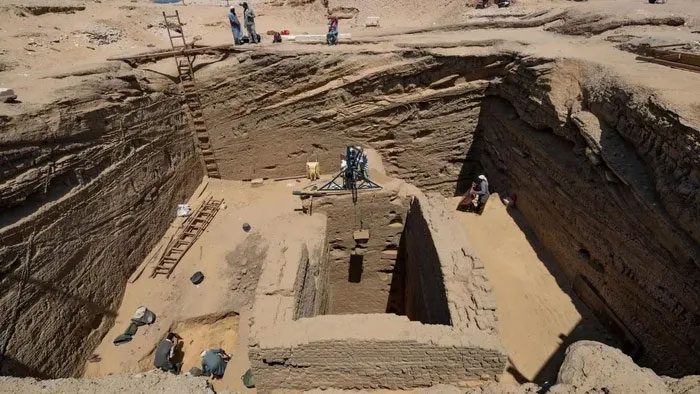Egyptian archaeologists have uncovered a 2,600-year-old tomb belonging to a high-ranking individual: the leader of a foreign mercenary group named Wahibre-mery-Neith.

The tomb discovered during the excavation in Abusir, Egypt.
A team of Egyptian and Czech researchers reported that this tomb contained over 370 ceramic jars filled with materials used in the mummification process of this leader, making it the largest mummification storage facility ever found in Egypt. The tomb is located in Abusir, just a few kilometers south of the vast necropolis at Saqqara.
Although tomb robbers had stolen the ancient mummified remains of Wahibre-mery-Neith, archaeologists found the remnants of a sarcophagus inscribed with hieroglyphs. These inscriptions reveal his identity and quote a portion of Chapter 72 from the Book of the Dead, describing the resurrection of the deceased and their journey to the afterlife.
As the commander of mercenaries in ancient Egypt, Wahibre-mery-Neith was likely responsible for overseeing and leading soldiers from the Aegean Islands and Anatolia.

Numerous ceramic jars buried with the mummy found in the tomb
The leader’s sarcophagus had been stolen, and the mummy had vanished. He lived during the late 26th Dynasty (around 688 BC to 525 BC) or the early 27th Dynasty (525 BC to 404 BC). While Egypt was independent during the 26th Dynasty, the 27th Dynasty saw the country ruled by the Persians.
Despite the increasing foreign influence, Wahibre-mery-Neith appears to have been a local, based on his name and the artifacts found in his tomb, according to Miroslav Bárta, the Czech excavation director in Egypt.
This tomb was also buried with 402 glazed ceramic shabti figures. Ancient Egyptians believed that shabtis served the deceased in the afterlife and they were commonly found in Egyptian tombs. Other discoveries included a heart scarab, an amulet, and an ostracon (a piece of pottery) inscribed with additional spells from the Book of the Dead.
Daniel Gómez-Castro, a historian who has extensively researched and written about Greek mercenaries in the ancient world, noted that it is intriguing that no armor or weapons were found in the tomb. It is possible that Wahibre was not a battlefield commander but rather an administrator handling the affairs of the mercenaries. If Wahibre lived during the period of Persian control over Egypt, he might have been a relative of a “Dinast”, appointed by the Persians with a degree of local authority.





















































